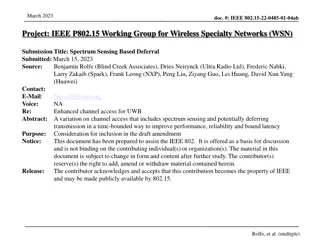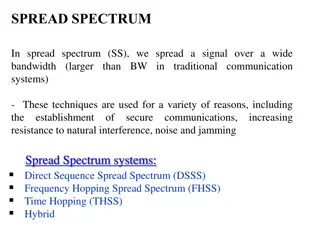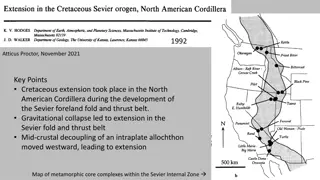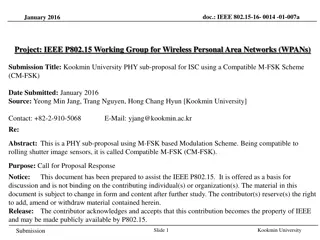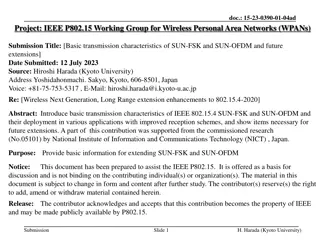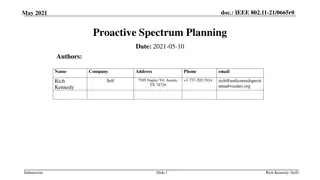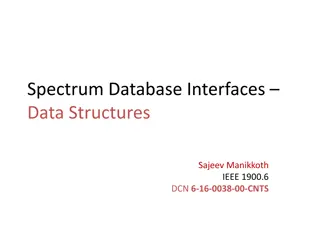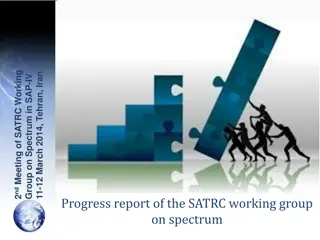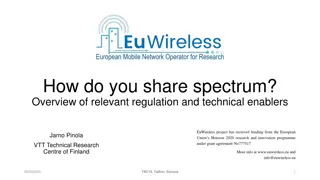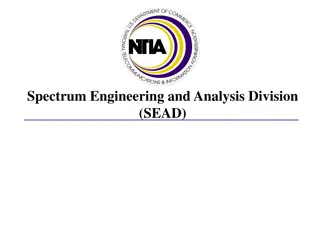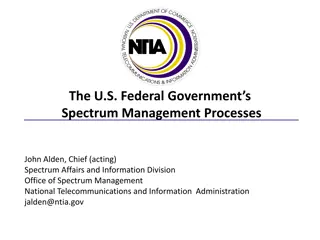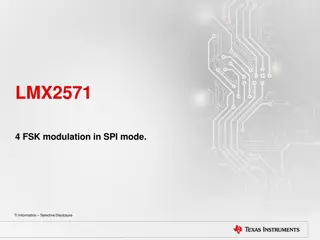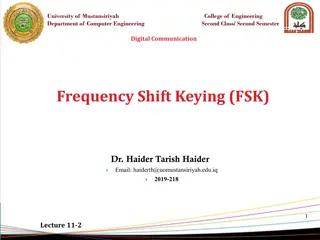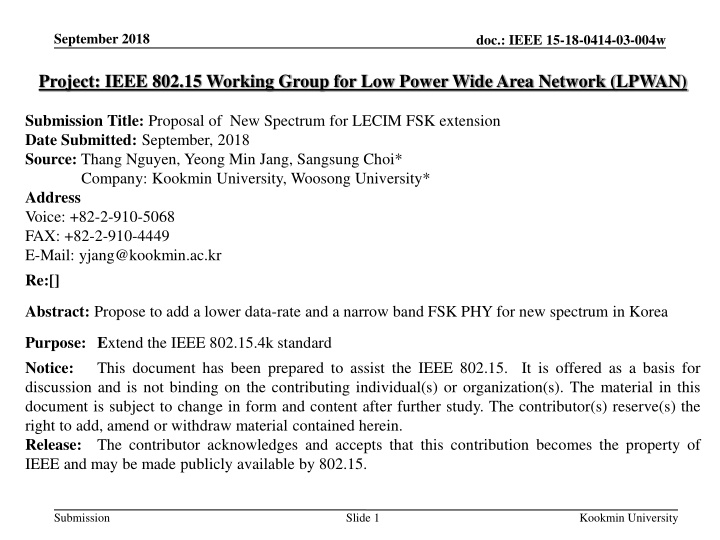
Proposal for New Spectrum in Korea for IEEE 802.15.4k Standard Extension
Explore a proposal for adding a lower data-rate and narrowband FSK PHY to introduce new spectrum in Korea for extending the IEEE 802.15.4k standard aimed at enhancing connectivity in low power wide area networks.
Download Presentation

Please find below an Image/Link to download the presentation.
The content on the website is provided AS IS for your information and personal use only. It may not be sold, licensed, or shared on other websites without obtaining consent from the author. If you encounter any issues during the download, it is possible that the publisher has removed the file from their server.
You are allowed to download the files provided on this website for personal or commercial use, subject to the condition that they are used lawfully. All files are the property of their respective owners.
The content on the website is provided AS IS for your information and personal use only. It may not be sold, licensed, or shared on other websites without obtaining consent from the author.
E N D
Presentation Transcript
September 2018 doc.: IEEE 15-18-0414-03-004w Project: IEEE 802.15 Working Group for Low Power Wide Area Network (LPWAN) Submission Title: Proposal of New Spectrum for LECIM FSK extension Date Submitted: September, 2018 Source: Thang Nguyen, Yeong Min Jang, Sangsung Choi* Company: Kookmin University, Woosong University* Address Voice: +82-2-910-5068 FAX: +82-2-910-4449 E-Mail: yjang@kookmin.ac.kr Re:[] Abstract: Propose to add a lower data-rate and a narrow band FSK PHY for new spectrum in Korea Purpose: Extend the IEEE 802.15.4k standard Notice: This document has been prepared to assist the IEEE 802.15. It is offered as a basis for discussion and is not binding on the contributing individual(s) or organization(s). The material in this document is subject to change in form and content after further study. The contributor(s) reserve(s) the right to add, amend or withdraw material contained herein. Release: The contributor acknowledges and accepts that this contribution becomes the property of IEEE and may be made publicly available by 802.15. Submission Slide 1 Kookmin University
September 2018 doc.: IEEE 15-18-0414-03-004w Background 802.15 TG4w Scope This amendment defines a Low Power Wide Area Network (LPWAN) extension to the IEEE Std 802.15.4 Low Energy, Critical Infrastructure Monitoring (LECIM) PHY layer to cover network cell radii of typically 10-15 km in rural areas. It uses the LECIM PHY Frequency Shift Keying (FSK) modulation schemes with extensions to lower bit-rates (e.g. payload bit- rate typically <30 kb/s). Additionally, it extends the frequency bands to additional sub-GHz unlicensed and licensed frequency bands to cover the market demand. For improved data integrity in channels with high levels of interference, it defines mechanisms for the fragmented transmission of Forward Error Correction (FEC) code-words, as well as time and frequency patterns for the transmission of the fragments. Modifications to the Medium Access Control (MAC) layer, needed to support this PHY extension, are defined. Slide 2 Submission Kookmin University
September 2018 doc.: IEEE 15-18-0414-03-004w Overview of Proposal(1) Propose to add a lower data-rate(<12.5Kbps) in current FSK LECIM PHY Standard Add 6.25Kbps with modulation index 2.0 It is convenient to change data-rates without changing modulation schemes Submission Slide 3 Kookmin University
September 2018 doc.: IEEE 15-18-0414-03-004w Overview of Proposal(2) Propose a narrowband FSK LECIM PHY for new spectrum(262 ~ 264MHz) in Korea Flexible channel bandwidth (<200KHz) of new spectrum in Korea allows to adapt the narrow band FSK transceivers Add 2 low data-rates(2.4, 4.8Kbps) in 262 ~ 264MHz band, which use 12.5KHz channel spacing Submission Slide 4 Kookmin University
September 2018 doc.: IEEE 15-18-0414-03-004w Overview of Proposal(3) Propose the SFD Sequence spreading/dispreading scheme for reliable packet detection at low SNR Current SFD sequence has poor PMR performance at low SNR The overall PER performance is limited by PMR performance due to SFD detection failure at low-SNR A simple SFD sequence spreading scheme to improve SFD detection performance Submission Slide 5 Kookmin University
September 2018 doc.: IEEE 15-18-0414-03-004w Motivations(1) The lower data-rates (<12.5Kbps) are very important in the world because they provide many options for extension of communication ranges in IoT services Many FSK transceivers are already deployed in the world today It is convenient to change data-rates without changing modulation schemes Submission Slide 6 Kookmin University
September 2018 doc.: IEEE 15-18-0414-03-004w Motivations(2) Recently Korean government allocated 2 unlicensed frequency bands for IoT services, and the IoT market in Korea requires a new narrow band radio transceiver in those frequency bands. 262~264MHz and 940.1~946.3 MHz bands were allocated in Korea recently. Spectrum efficiency of current LECIM is not good in Korea because it must keep the fixed center frequency every 200KHz in 917~923.5MHz New spectrum(262~264MHz) is suitable to adapt the narrow band FSK LECIM because it allows flexible channel bandwidth (<200 KHz) Submission Slide 7 Kookmin University
September 2018 doc.: IEEE 15-18-0414-03-004w Motivations(3) Current SFD detection in FSK LECIM PHY is required to improve the performance because of poor PMR in low SNR The overall PER performance is limited by PMR performance due to SFD detection failure at low-SNR. Note that LECIM standard includes the reliability enhancing schemes (FEC, spreading) only for PHR+PSDU part. It is necessary to improve the reliability of the SFD sequence, which can shift the PMR curve to the left for the successful packet recovery at low-SNR Submission Slide 8 Kookmin University
September 2018 doc.: IEEE 15-18-0414-03-004w Extension proposal #1 Current Data-rates in FSK LECIM(1) 2 data-rate modes are provides for 169MHz band 25Kbps with modulation index 0.5 12.5Kbps with modulation index 0.5 Frequency Band Parameter Operating Mode #1 Operating Mode #2 Data-rate 25kbps 12.5kbps 2-FSK P-FSK 2-FSK P-FSK Modulation 169MHz Modulation Index 0.5 1.0 Channel Spacing Submission Slide 9 Kookmin University
September 2018 doc.: IEEE 15-18-0414-03-004w Extension proposal #1 Current Data-rates in FSK LECIM(2) 3 data-rate modes are provided for all other bands 37.5Kbps with modulation index 0.5 25Kbps with modulation index 1.0 12.5Kbps with modulation index 2. Either 100kHz or 200kHz channel spacing may be used as permitted by local regulations. Frequency Band Parameter Operating Mode #1 Operating Mode #2 Operating Mode #3 Data-rate 37.5kbps 25kbps 12.5kbps 2-FSK P-FSK 2-FSK P-FSK 2-FSK P-FSK Modulation For all other bands Modulation Index 0.5 1.0 2.0 Channel Spacing 100/200KHz 100/200KHz 100/200KHz Submission Slide 10 Kookmin University
September 2018 doc.: IEEE 15-18-0414-03-004w Extension proposal #1 LECIM FSK Operating Mode IE As defined in table 7.31, there is only 1 filed value reserved, add optional PHY as defined in table below Submission Slide 11 Kookmin University
September 2018 doc.: IEEE 15-18-0414-03-004w Extension proposal #1 Additional lower data-rate modes in FSK LECIM PHY Add 6.25Kbps with modulation index 2.0 Expect to improve 3dB of sensitivity compare to 12.5Kbps without changing modulation scheme Frequency Band Parameter Operating Mode #1 Operating Mode #2 Operating Mode #3 Operating Mode #4 37.5 (kbps) 25.0 (kbps) 12.5 (kbps) 6.25 (kbps) Data-rate 2-FSK P-FSK 2-FSK P-FSK 2-FSK P-FSK 2-FSK P-FSK Modulation For all other bands Modulation Index 0.5 1.0 2.0 2.0 Channel Spacing 100/200 (KHz) 100/200 (KHz) 100/200 (KHz) 100/200 (KHz) The nominal frequency deviation, fdev, shall be (symbol rate modulation index)/2. Submission Slide 12 Kookmin University
September 2018 doc.: IEEE 15-18-0414-03-004w Extension proposal #2 Current spectrum in Korea 917~923.5MHz Band 32 channels with channel band width 200KHz (fixed center frequency) Different radiated power limits depend on service CH.1, 3, 4, 6, 7, 9, 10, 12, 13, 15, 16, 18 3mW CH. 2, 5, 8, 11, 14, 17, 19, 20~25 10mW CH. 26 ~ 32 25mW Must use Duty Cycle or LBT or Frequency Hopping DRM RFID Reader RFID Tag 2 5 8 11 14 17 19 20 21 22 23 24 25 26 27 28 29 30 31 32 1 3 4 6 7 9 10 12 13 15 16 18 Mobile RFID Radio pager 917 920.6 923.5 924.5 Submission Slide 13 Kookmin University
September 2018 doc.: IEEE 15-18-0414-03-004w Extension proposal #2 New spectrum in Korea 262~264MHz band General bandwidth: channel spacing 200 kHz Narrow bandwidth: can use channel spacing 12.5 kHz for IoT services Must use duty cycle 12.5 KHz/channel * 16 channel 200 KHz/channel * 9 channels Submission Slide 14 Kookmin University
September 2018 doc.: IEEE 15-18-0414-03-004w Extension proposal #2 Propose a narrowband FSK LECIM PHY in 262~ 264MHz 2 lower data-rates: 2.4kbps and 4.8Kbps - 2.4Kbps with modulation index 2.0 - 4.8Kbps with modulation index 1.0 12.5KHz channel spacing Frequency Band Parameter Operating Mode #1 Operating Mode #2 Data-rate 2.4kbps 4.8kbps Modulation GFSK GFSK 262~264 (MHz) Modulation Index 2 1.0 Channel Spacing 12.5KHz 12.5KHz Submission Slide 15 Kookmin University
September 2018 doc.: IEEE 15-18-0414-03-004w Extension proposal #3 Packet format in LECIM Each packet has a header called a synchronization header (SHR) that performs synchronization, followed by the body of the packet (PHR and PSDU) that contains the data. SHR: Preamble & SFD Once the SFD contained in SHR is detected, the subsequent recovery process of PHR and PSDU bits can be performed Submission Slide 16 Kookmin University
September 2018 doc.: IEEE 15-18-0414-03-004w Extension proposal #3 Synchronization performance at low SNR Reliability enhancement techniques apply only PHR and PSDU FEC with K=4 and K=7 Spreading with SF=2,4,8, and 16 SFD sequence in LECIM fails to ensure reliability at low-SNR SFD sequence has a length of 2 or 3 octets designed to reduce the FAR of the packet Submission Slide 17 Kookmin University
September 2018 doc.: IEEE 15-18-0414-03-004w Extension proposal #3 Propose SFD Spreading/Dispreading scheme Apply spreading scheme to the SFD sequence to maintain SHR at a level of similar to the reliability of PHR and PSDU This method improves Packet Missing Rate(PMR) performance while maintaining FAR performance A single SFD sequence input bit (b0) is mapped into the SFD sequence spreading bits (c0, , cSF-1) - Suggest SF = 2, 4, 8 Submission Slide 18 Kookmin University
September 2018 doc.: IEEE 15-18-0414-03-004w Extension proposal #3 Simulation of PER performance(1) PER performance consists of PMR and PHR + PSDU error rate PMR performance indicates SFD detection failure Overall PER includes the PMR as well as the error rate occurring in PHR and PSDU PMR performance, is relatively poor and is only 1 dB performance gap compared with error rate of PHR and PSDU No FEC and spreading schemes are applied to PHR and PSDU Applying optional FEC or spreading schemes to PHR and PSDU PHR + PSDU error rate curve shifts the left (e.g. more than 3 dB) PMR curve remains the same. The overall PER performance is limited by PMR due to SFD detection failure at low-SNR SFD detection is required to improve the performance Submission Slide 19 Kookmin University
September 2018 doc.: IEEE 15-18-0414-03-004w Extension proposal #3 Simulation of PER performance(2) 0 10 -1 10 Error Rate -2 10 PHR+PSDU error rate PMR -3 10 9 10 11 12 13 14 15 Eb/No [dB] Submission Slide 20 Kookmin University
September 2018 doc.: IEEE 15-18-0414-03-004w Extension proposal #3 Simulation results of proposed SFD sequence spreading(1) Spreading is applied to the SFD sequence Simulation results show that synchronization performance is improved SF 4: improve PMR 2.5dB SF 8: improve PMR 3.5dB The proposed SFD sequence spreading scheme with reliability enhancement schemes (e.g., FEC and spreading) to the PHR and PSDU enables the operating SNR of 10 dB at PER 10-2 It results in an 80 % increase in communication range Submission Slide 21 Kookmin University
September 2018 doc.: IEEE 15-18-0414-03-004w Extension proposal #3 Simulation results of proposed SFD sequence spreading(2) 10 PMR performance 0 PMR (SF = 1) PMR (SF = 4) PMR (SF = 8) -1 10 PMR -2 10 -3 10 9 9.5 10 10.5 11 11.5 12 12.5 13 13.5 14 Eb/No [dB] Submission Slide 22 Kookmin University
September 2018 doc.: IEEE 15-18-0414-03-004w Conclusions Propose to add lower data rates (<12.5 kbps) in LECIM FSK PHY for ISM bands Add 6.25Kbps with modulation index 2 It is convenient to change data-rates without changing modulation schemes Propose a narrowband system for new spectrum(262~264MHz) in Korea 2.4 and 4.8Kbps in 12.5KHz channel spacing Satisfy customer s request in Korean IoT market Propose SFD spreading/dispreading scheme Spreading is applied to the SFD sequence Improve SFD detection performance in low SNR Submission Slide 23 Kookmin University
September 2018 doc.: IEEE 15-18-0414-03-004w Abbreviations LECIM Low Energy Critical Infrastructure Monitoring GFSK Gaussian Frequency Shift Keying PHR PHY header PPDU PHY protocol data unit PSDU PHY service data unit SFD Synchronization Frame Delimiter SHR Synchronization header ISM Industrial Scientific Medical Submission Slide 24 Kookmin University
September 2018 doc.: IEEE 15-18-0414-03-004w References [1] IEEE Standard for Low-Rate Wireless Personal Area Networks (WPANs) 802.15.4w Technical Guidance Document; 12 March, 2018; 15-18-0161-00-004w P802.15.4w PAR P802.15.4w CSD [2] [3] [4] Submission Slide 25 Kookmin University






